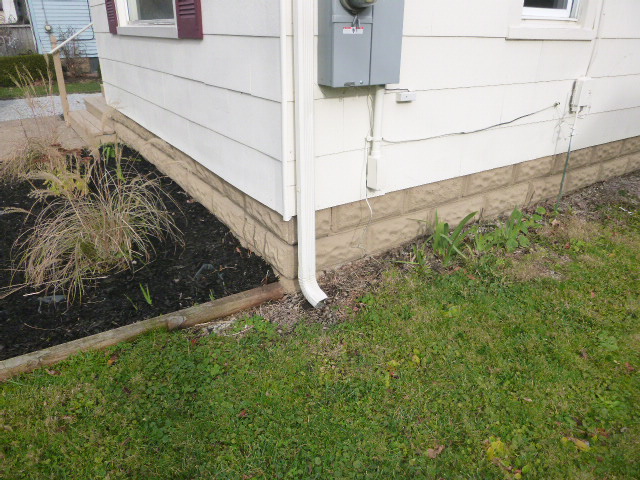
For most people, gutters and downspouts are usually an afterthought.
These components of your home don’t seem to do much, and may go unnoticed by occupants of a home until they are not performing their intended function and leaking, or you notice water leaking in your basement.
When it rains, or the snow melts from your roof, massive amounts of water will drain off the rooftop, and will fall down around the exterior of your home. Gutters are designed to catch rain water that falls onto the roof of your home and direct that fallen roof water to a nearby downspout.
The downspout should then lead the roof water down the side of the house, and away from the foundation of the home, to prevent water intrusion into the basement or crawlspace walls which can lead to damaged or leaky foundations, rotted wood, or mold growth inside the lower levels of the home.
Downspouts will run down from the gutters around the roof eaves, down to the ground, where they will either
travel underground via underground storm-sewer drains to a city storm-sewer, or they can run to a nearby storm water run-off/reservoir; or the downspouts will simply discharge out onto the yard.
Downspouts that empty out onto the yard around the house are common in rural areas that do not have storm-sewer infrastructure. Downspouts that discharge out onto the yard are also very common at garages, outbuildings, and sheds. Many times, people do not think about where all of the rain water will go once they let a downspout pipe pour the water out near their home. Such is the case when water in the downspouts empties out onto a garden bed, somewhere within six feet of the home, or a downspout pipe that is discharging water towards a low spot around the exterior of the home.
Often times water easily accumulates around the home because downspouts are pouring water out within close proximity to the home. Remember that over time, every time that it rains, water accumulates closely around these downspout pipes that are emptying out near the foundation or against the basement walls of the home.
The above mentioned water accumulation around the exterior of the home will usually causes a water stain or efflorescence to appear from grade level on down the foundation wall, as observed from inside of the basement or crawlspace.
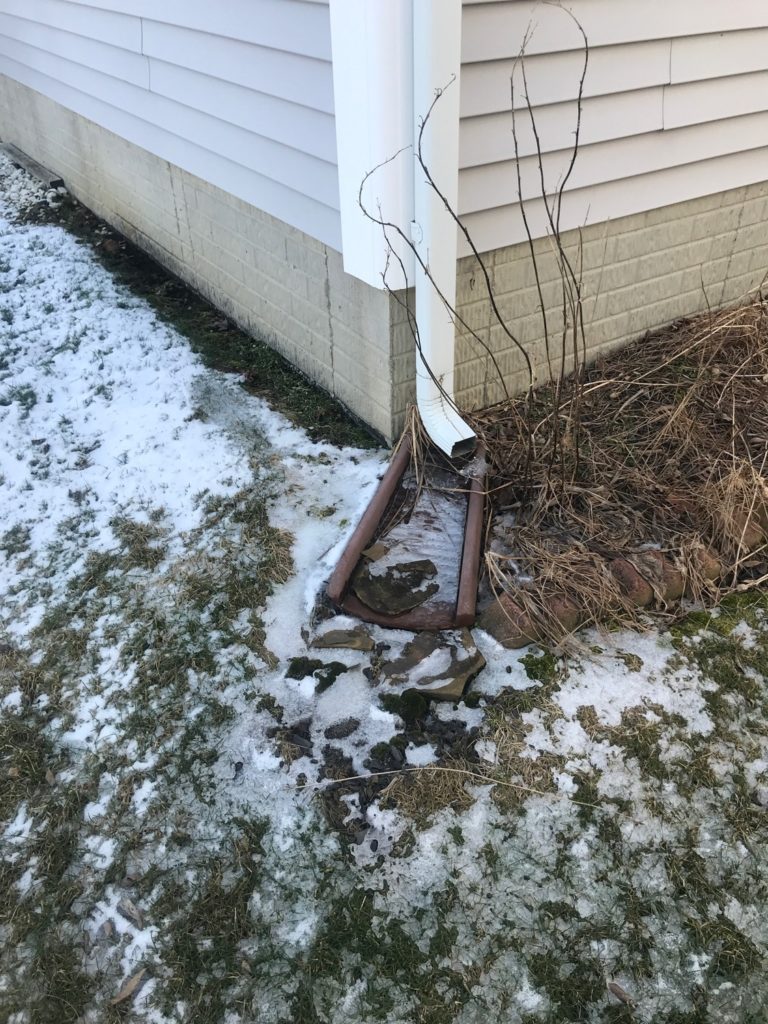
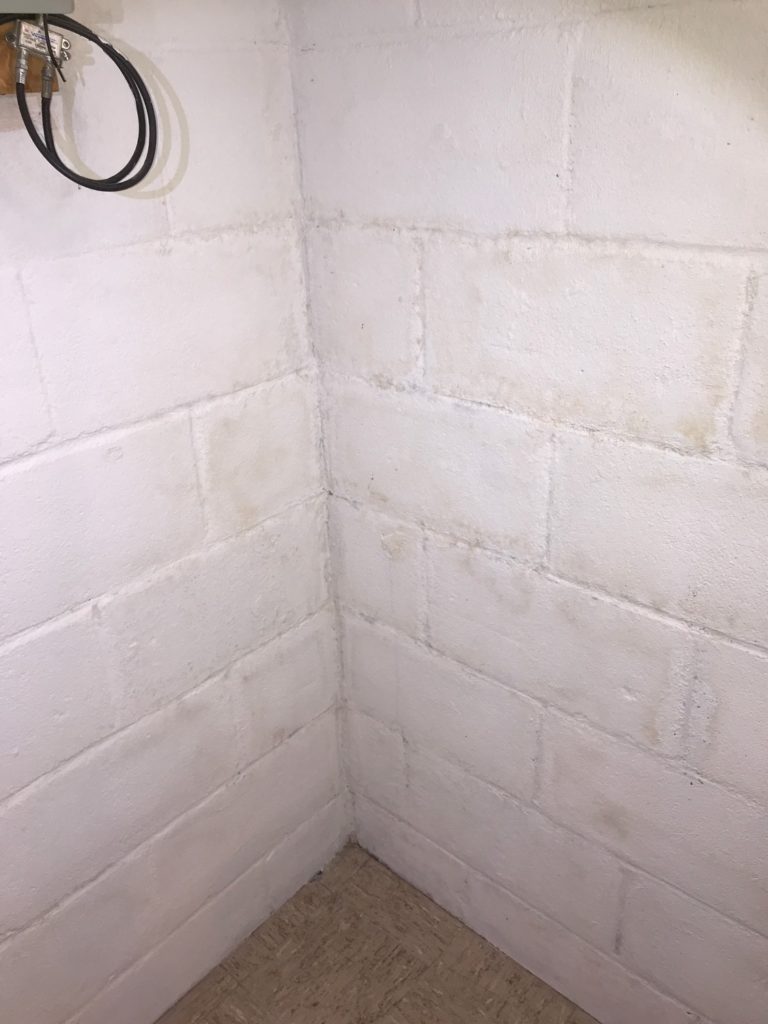
Correction would usually require extending the downspouts further away from the foundation walls so as to avoid water accumulation near or against them, which is usually a direct cause of localized water seepage or leakage. These downspout extension tubes are generally very affordable and can be found on Amazon by clicking on the photo below.
- Pro-Tip: Corrugated plastic downspout extension tubes are more ideal to use for directing water away from the foundation walls than splash blocks. Splash blocks are the smaller 1-2 feet long plastic tray-like diverters but these do not seem to extend the water far enough away from the foundation and these tend to fail over a number of years. Instead, corrugated plastic tubes typically extend to around 4 feet or longer, and can be connected together to extend longer, which is ideal for directing discharging water as far away from the walls of the home or structure as possible.
Splash blocks do not extend the water as far and typically become knocked over or sloped backwards towards the home over time which prevents the splash block from fulfilling its intended use.
It is important to direct downspout extension tubes towards an area of the yard or garden that is both away from the foundation, and also to an area where the ground is sloping positively away from the foundation. There is no use extending a downspout away from a home if the slope of the yard is slanting backwards towards the home. Be sure to direct your downspout extension tubes both away from the structure/foundation and also on a piece of land that slopes properly away from the foundation.
Safety Concern: One more important tip is to avoid discharging downspouts out onto a stone or cement walkway. This water that flows out from the downspouts can freeze and cause a slippery trip hazard or other safety concern for occupants of the home/building during freezing temperatures. Downspouts ideally should discharge onto soil of some sort. (Grass, garden-bed, underground drain, etc.)
Remember to ensure that the water does not empty onto a garden bed that sits up against the foundation walls of the building, especially where dampness is occurring inside , because the garden bed can hold water against the outside of the leaky walls and exacerbate the issue.

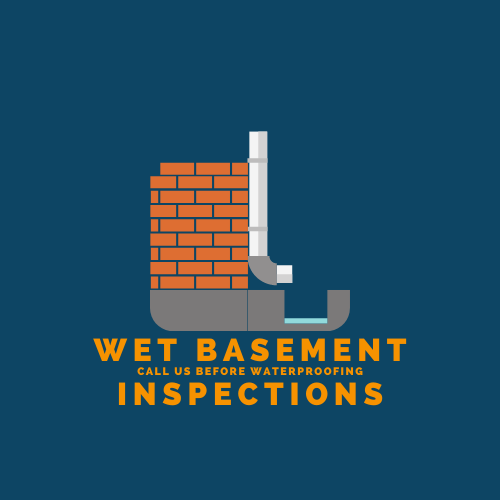
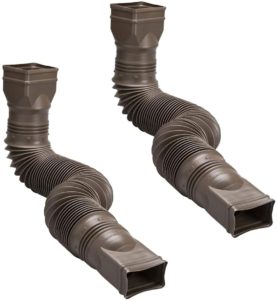
Wow…what an informative site!
Can you post more information about the products you would use to resolve these issues?
Yea thanks so much! Glad you find this stuff helpful. Ill go back up and post some links inside of the article to some of the products that I have used for my home and for client’s properties.
I know this website presents quality dependent articles or reviews and extra stuff,
is there any other site which offers these kinds of stuff in quality?
I do not know of many other sites that are posting original content with regards to experience or product reviews. All of these products I own, use, or have used before in the past. I will continue to add more content as I document my experiences both as a home inspector, wet basement consultant, and rental property owner. The aim at wetbasementinspections.com is that you find the site value-able enough that eventually there will be no need to search elsewhere for questions with regards to keeping your leaky foundations dry and comfortable. Hopefully these articles help you to regain useable space in your basement once again.
I was very pleased to uncover this web site. I want to to thank you for your time due to this fantastic read!! I definitely appreciated every bit of it and I have you bookmarked to look at new things on your website.
מזהה רוצה תודה על המאמצים יש לך לשים כותב את זה אתר. אני מקווה להציג אותו בדרגה גבוהה פוסטים על ידך בהמשך גם כן. למען האמת, יכולות הכתיבה היצירתית שלך יש עודד לי לקבל שלי מאוד משלו אתר עכשיו;)
Thanks so much! I am glad you enjoy it!
Its like you learn my mind! You appear to understand so much about this,
such as you wrote the guide in it or something. I believe that you just can do with some p.c.
to pressure the message house a bit, however instead of that, this
is magnificent blog. An excellent read. I will definitely be back.
Thanks for you input and encouragement!
Hey there! I’m at work browsing your blog from my new
iphone! Just wanted to say I love reading through your blog and look forward to all your posts!
Carry on the fantastic work!
Excellent post! We are linking to this great post on our site.
Keep up the great writing.
Thanks so much! Glad you find this useful!
It’s an remarkable post in favor of all the online
users; they will obtain benefit from it I am sure.
Appreciate your input!
Thanks for finally writing about > Home – Wet
Basement Inspections < Liked it!
Thanks a million!
Hey very interesting blog!
Your way of explaining the whole thing in this article is really nice, every one be capable of simply understand it, Thanks a lot.
Hi there, just became aware of your blog through Google, and found that it is truly informative.
I am going to watch out for brussels. I?ll appreciate if you continue this
in future. Lots of people will be benefited from your writing.
Cheers!
I think this is among the most important information for me.
And i am glad reading your article. But want to remark on some general things, The website style is
wonderful, the articles is really nice : D. Good job,
cheers